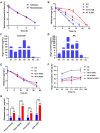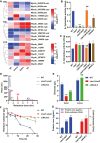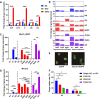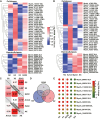Independent metabolism of oligosaccharides is the keystone of synchronous utilization of cellulose and hemicellulose in Myceliophthora
- PMID: 38380057
- PMCID: PMC10877092
- DOI: 10.1093/pnasnexus/pgae053
Independent metabolism of oligosaccharides is the keystone of synchronous utilization of cellulose and hemicellulose in Myceliophthora
Abstract
The effective utilization of cellulose and hemicellulose, the main components of plant biomass, is a key technical obstacle that needs to be overcome for the economic viability of lignocellulosic biorefineries. Here, we firstly demonstrated that the thermophilic cellulolytic fungus Myceliophthora thermophila can simultaneously utilize cellulose and hemicellulose, as evidenced by the independent uptake and intracellular metabolism of cellodextrin and xylodextrin. When plant biomass serviced as carbon source, we detected the cellodextrin and xylodextrin both in cells and in the culture medium, as well as high enzyme activities related to extracellular oligosaccharide formation and intracellular oligosaccharide hydrolysis. Sugar consumption assay revealed that in contrast to inhibitory effect of glucose on xylose and cellodextrin/xylodextrin consumption in mixed-carbon media, cellodextrin and xylodextrin were synchronously utilized in this fungus. Transcriptomic analysis also indicated simultaneous induction of the genes involved in cellodextrin and xylodextrin metabolic pathway, suggesting carbon catabolite repression (CCR) is triggered by extracellular glucose and can be eliminated by the intracellular hydrolysis and metabolism of oligosaccharides. The xylodextrin transporter MtCDT-2 was observed to preferentially transport xylobiose and tolerate high cellobiose concentrations, which helps to bypass the inhibition of xylobiose uptake. Furthermore, the expression of cellulase and hemicellulase genes was independently induced by their corresponding inducers, which enabled this strain to synchronously utilize cellulose and hemicellulose. Taken together, the data presented herein will further elucidate the degradation of plant biomass by fungi, with implications for the development of consolidated bioprocessing-based lignocellulosic biorefinery.
Keywords: Myceliophthora thermophila; carbon catabolite repression; cellulose and hemicellulose; fungal biotechnology; independent utilization.
© The Author(s) 2024. Published by Oxford University Press on behalf of National Academy of Sciences.
Figures





Similar articles
-
Dissecting cellobiose metabolic pathway and its application in biorefinery through consolidated bioprocessing in Myceliophthora thermophila.Fungal Biol Biotechnol. 2019 Nov 13;6:21. doi: 10.1186/s40694-019-0083-8. eCollection 2019. Fungal Biol Biotechnol. 2019. PMID: 31754437 Free PMC article.
-
Metabolic engineering of the cellulolytic thermophilic fungus Myceliophthora thermophila to produce ethanol from cellobiose.Biotechnol Biofuels. 2020 Feb 1;13:23. doi: 10.1186/s13068-020-1661-y. eCollection 2020. Biotechnol Biofuels. 2020. PMID: 32021654 Free PMC article.
-
Evidence of a critical role for cellodextrin transporte 2 (CDT-2) in both cellulose and hemicellulose degradation and utilization in Neurospora crassa.PLoS One. 2014 Feb 20;9(2):e89330. doi: 10.1371/journal.pone.0089330. eCollection 2014. PLoS One. 2014. PMID: 24586693 Free PMC article.
-
Intracellular cellobiose metabolism and its applications in lignocellulose-based biorefineries.Bioresour Technol. 2017 Sep;239:496-506. doi: 10.1016/j.biortech.2017.05.001. Epub 2017 May 4. Bioresour Technol. 2017. PMID: 28535986 Review.
-
Enhancing the Co-utilization of Biomass-Derived Mixed Sugars by Yeasts.Front Microbiol. 2019 Jan 22;9:3264. doi: 10.3389/fmicb.2018.03264. eCollection 2018. Front Microbiol. 2019. PMID: 30723464 Free PMC article. Review.
Cited by
-
Advances in fungal sugar transporters: unlocking the potential of second-generation bioethanol production.Appl Microbiol Biotechnol. 2025 Jan 22;109(1):19. doi: 10.1007/s00253-025-13408-2. Appl Microbiol Biotechnol. 2025. PMID: 39841260 Free PMC article. Review.
-
Dual Role of MtHAC-1 in Regulating Cellulase and Xylanase Production in Myceliophthora thermophila.Microb Biotechnol. 2025 Aug;18(8):e70203. doi: 10.1111/1751-7915.70203. Microb Biotechnol. 2025. PMID: 40739661 Free PMC article.
-
MTD: A cloud-based omics database and interactive platform for Myceliophthora thermophila.Synth Syst Biotechnol. 2025 Apr 3;10(3):783-793. doi: 10.1016/j.synbio.2025.04.001. eCollection 2025 Sep. Synth Syst Biotechnol. 2025. PMID: 40276250 Free PMC article.
References
-
- Lu H, Yadav V, Bilal M, Iqbal HMN. 2022. Bioprospecting microbial hosts to valorize lignocellulose biomass—environmental perspectives and value-added bioproducts. Chemosphere. 288(Pt 2):132574. - PubMed
-
- Gírio FM, et al. . 2010. Hemicelluloses for fuel ethanol: a review. Bioresour Technol. 101(13):4775–4800. - PubMed
-
- Zhong R, Cui D, Ye ZH. 2017. Regiospecific acetylation of xylan is mediated by a group of DUF231-containing O-acetyltransferases. Plant Cell Physiol. 58(12):2126–2138. - PubMed
-
- Sindhu R, Binod P, Pandey A. 2016. Biological pretreatment of lignocellulosic biomass—an overview. Bioresour Technol. 199:76–82. - PubMed
LinkOut - more resources
Full Text Sources
Molecular Biology Databases

